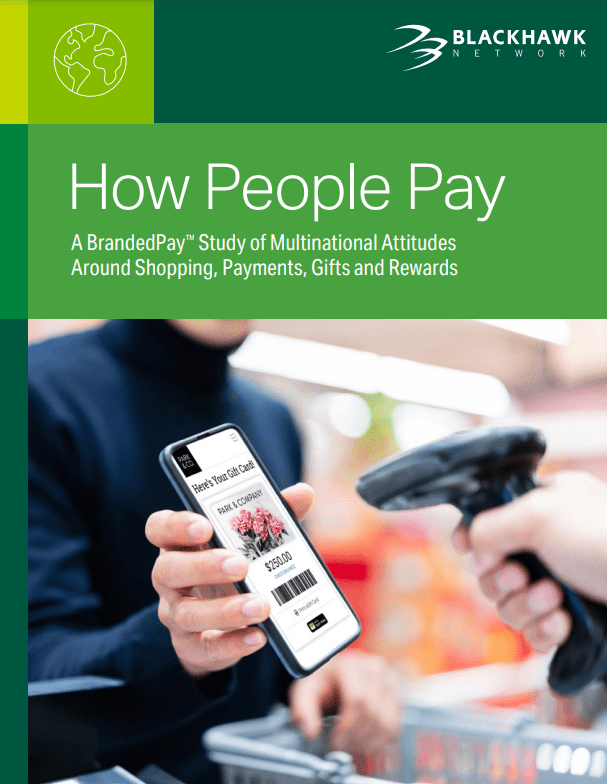Podcast: Play in new window | Download
It likely comes as no surprise to hear that COVID-19 has dramatically changed shopper preferences and behavior, and how consumers pay. But just how much change has occurred, and what does this mean for retailers and other businesses looking to better serve their customers?
With the goal of examining attitudes and behaviors around shopping, payments, and gifts, Blackhawk Network surveyed thousands of consumers across the globe for its 2020 Multinational BrandedPay™ report. The report contains both the results of research conducted before the peak impact of the pandemic and supplemental data gathered during the phased re-openings.
To talk more about the emerging trends in consumer behavior identified by the report, PaymentsJournal sat down with Theresa McEndree, VP of Marketing at Blackhawk Network and Ted Iacobuzio, VP and Managing Director of Research at Mercator Advisory Group.
Digital wallet adoption is surging
One of the most noteworthy findings of the BrandedPay™ report is that 88% of surveyed shoppers in eight markets reported using a digital wallet of some kind. While the payments industry has been attempting to drive adoption for years, COVID-19 has served as a major catalyst for consumers to incorporate digital wallets into their lives.
A number of factors contribute to the recent uptick in digital wallet adoption. “People have been forced to shift their behavior both from a security and accessibility standpoint, as well as a feeling of safety,” explained McEndree. Consumers like the thought of using their own device in a contactless setting to avoid potential exposure to the virus, which has led them to “really cross the chasm, so to speak, to adoption,” she added.
Iacobuzio agreed, adding that “consumers have discovered that mobile wallets are an exceptionally safe, convenient, and instantaneous way to pay, and COVID-19 has given them the extra shove they needed to move into that territory.”
Consumer usage of digital wallets varies by market
Of course, the level of saturation of digital wallets varies by market. For example, while 90% of Americans reported having a digital wallet of some kind, only one in three regularly use a digital wallet to make purchases.
Comparatively, consumers in Mexico are much less likely to have digital wallets, with only 60% of surveyed respondents reporting having one. Wallet security concerns and lack of acceptance at retailers were among the greatest barriers to wider adoption of this payment type in Mexico.
There are also differences in how digital wallet users view the wallets. A meager 23% of those who use a digital wallet in Germany agree that they shop more often since getting a digital wallet, while 34% agree that using a digital wallet has made shopping easier. Meanwhile, 62% of Brazil-based digital wallet users agree that they shop more often since getting a digital wallet, and 73% agree that digital wallets make shopping easier.
Like digital wallets, digital gift cards are seeing noteworthy growth
Whether it be new social distancing protocols or requirements to wear masks, the pandemic has disrupted the entire in-store shopping experience. Consequently, digital gifting and buying gift cards online has become a more embraced method of not only gifting to others, but purchasing products for self-use. In fact, Blackhawk’s report found that more than half of surveyed consumers have now purchased or received a digital gift card.
Others are using digital gifting as a budgeting or content management method for themselves or their children. For example, a parent might not give their 12 year old a credit card, but will give them a $20 Roblox gift card. With the use cases for digital gift cards growing, “a lot of emerging or ascendant brands have leaned into digital gifting to acquire and grow their customer base,” added McEndree.
Digital gift cards aren’t just being used by consumers to give to friends and family. Companies are embracing this type of payment, too, as a way to engage with their employees in new ways. For example, businesses looking to host a digital lunch can send digital gift cards to employees to buy them lunch.
Online shopping has pulled ahead of in-store experiences
Blackhawk also found that 53% of consumers reported shopping more frequently online than they do in-store. From traditional e-commerce purchases to ordering online for contactless curbside pickup, consumers have largely migrated to online shopping amid the pandemic.
Similar to Blackhawk’s findings, Mercator Advisory Group research has revealed that card, mobile, and other payment instruments are replacing cash and check transactions. Mercator’s findings “indicate that consumers are finally understanding that while cash may be desirable in a so-called ‘normal’ environment, digital money has too many advantages of physical month in the current environment,” said Iacobuzio.
Consumers’ digital shift should drive company innovation
While the end of the COVID-19 pandemic will likely mean that some customers revert to old shopping behaviors, much of the shift is here to stay as customers recognize the advantages of digital payments, mobile wallets, and online gift cards. In other words, things aren’t going back to how they were before—and companies need to respond accordingly.
As companies “think about their own brands and payment strategies, it is important to consider how to take the forced changes in consumer behavior and carry them forward as a great way to adapt and innovate the customer journey,” concluded Mc McEndree.
To unlock valuable insights into how consumers in numerous multinational markets view payments, what drives their buying behavior, and effective marketing tactics by market based on survey data, access the extensive report, How People Pay: A BrandedPay™ Study of Multinational Attitudes Around Shopping, Payments, Gifts and Rewards.
Access Blackhawk Network’s 2020 Multinational BrandedPay™ Report.
  |










